How Your Clothes Affect the Environment
Photo of clothing in a landfill from thenewdaily.com.
By Lauren Kleve, Intern
Do you ever think about the environmental or social impact of your clothes? Most people, even those who consider themselves environmentalists, don’t realize their choice in clothes greatly affects the environment and the people who are making their clothes!
Luckily, sustainable fashion is becoming more popular and accessible! In order for us to talk about sustainable fashion, you first need to understand what fast fashion is. Fast fashion refers to the mass production of low-cost clothing that mimics high-end fashion trends. Fast fashion brands are constantly coming out with new trends to be in style so that consumers feel the need to purchase more and stay “on trend.” Some of these brands actually release 52 “micro-seasons” a year of new clothing styles and trends! The clothes produced by fast fashion brands are not made to last and because of that and many other reasons, fast fashion involves extreme environmental and social implications.
Photo from fashionbeans.com
The low cost of fast fashion is appealing on the surface, but there are some serious underlying issues. The entire lifecycle of fast fashion is extremely harmful to the environment! The production of the materials to make these clothes is unsustainable; the production of the clothes themselves causes air and water pollution; the transportation causes more air pollution; the clothes are packaged in layers of plastic, styrofoam, cardboard, etc. to be able to be shipped; and ultimately leads to an immense amount of textile waste polluting our land and water.
The source of the materials making up your clothes has a huge ecological footprint. If someone heard their shirt was made from cotton, they would probably think that is a good thing for the environment, but actually inorganic cotton is responsible for one-fourth of the United States pesticide usage! Also, the common clothing material, polyester, is a synthetic fabric made from plastic! Additionally, the manufacturing process of polyester is extremely energy intensive and uses huge amounts of oil and releases harmful emissions.
Fast fashion is also polluting our oceans and bodies of water! Did you know that textile dyeing is the second largest polluter of clean water globally, after agriculture? However, the dyeing process is not the only part of fast fashion’s lifecycle that is polluting our water! Everytime you wash your clothes, synthetic and other fibers come off and drain with the rest of the water used to wash your clothes and enter our waterways! These microfibers are tiny plastic particles that pollute our oceans! “Every time we do our laundry, an average of 9 million microfibers are released into wastewater treatment plants, which cannot retrieve them and end up in the ocean” (oceancleanwash.org). They harm our environment, but they also harm us humans because those microfibers end up in what we eat and drink and are even raining down from the sky!
Photo from smartwatermagazine.com
People are purchasing more clothes faster than ever before, and the fast fashion clothes they are buying aren’t made to last. Because of this, clothes are now being disposed of left and right without a second thought! It is estimated that of the amount of clothes people buy each year, 21% of that is thrown out within the same year it is purchased. These clothing textiles are piling up in our landfills! Americans throw away more than 68 pounds of clothing and textiles per person per year!
Photo from thenewdaily.com
Fast fashion is also harmful to the people making the clothes. These people work in unsafe and dangerous conditions making unlivable wages, while being exposed to harmful chemicals that causes most workers to develop lung diseases and respiratory issues. There are also many cases of fast fashion garment building collapses. According to research done by the International Labor Rights Forum, at least 1800 garment workers have been killed in factory fires and building collapses in Bangladesh since 2005.
Fortunately, sustainable fashion exists so we can avoid supporting the awful process of fast fashion! Sustainable fashion supports ethical and environmentally conscious production and manufacturing methods of clothing. There are a lot of sustainable fashion brands out there! That being said, not all brands are created equal, so do some research to see which sustainable brands are a good fit for you! Remember, while no brand is perfect, by supporting sustainably conscious brands you are choosing to stand up against the unsustainable and unethical practices of the fast fashion industry!
Photo from Girlfriend Collective
Here is a list of some sustainable and ethical clothing brands you can check out:
Bydee Australia (swimwear and intimates)
Girlfriend Collective (my personal favorite brand)
Shopping from and supporting sustainable brands is a great eco-friendly option when buying clothes, but there is also another choice that can potentially reduce your clothes’ environmental impact even further! Wear second-hand clothes! This is a great budget friendly sustainable option that can also allow you to wear designer clothes or brands that you wouldn’t typically be able to purchase sustainably! Second-hand is awesome because it redirects clothes from entering landfills and polluting our earth!
Photo from sandytoesandpopsicles.com
Here are some places you can get clothes second hand:
Thrift stores
Consignment shops
Clothing swaps
Hand-me downs from friends and family
Online second hand shops (thredup, depop, poshmark, curtsy, etc.)
Instagram thrift shops (search “thrift” on instagram and a ton of thrift accounts will pop up!)
Fashion and clothing is a huge part of today’s society, and finding the style and clothes you like is still very possible when shopping sustainably! You don’t have to be perfect by only purchasing sustainable clothing from now on, but now that you know a little bit more about the fashion industry and its impacts, please consider adopting more sustainable practices when shopping for clothes in the future! Find the balance that works for you, and remember that every choice you make has an impact!
Sources:
Claudio, L. (2007). Waste Couture: Environmental Impact of the Clothing Industry. Environmental Health Perspectives, 115(9). doi: 10.1289/ehp.115-a449
Hobson, J. (2013). To die for? The health and safety of fast fashion. Occupational Medicine, 63(5), 317–319. doi: 10.1093/occmed/kqt079
Perry, P. (2018, January 3). The environmental costs of fast fashion. https://phys.org/news/2018-01-environmental-fast-fashion.html.
“The Issue.” Ocean Clean Wash. https://www.oceancleanwash.org/the-issue/.






